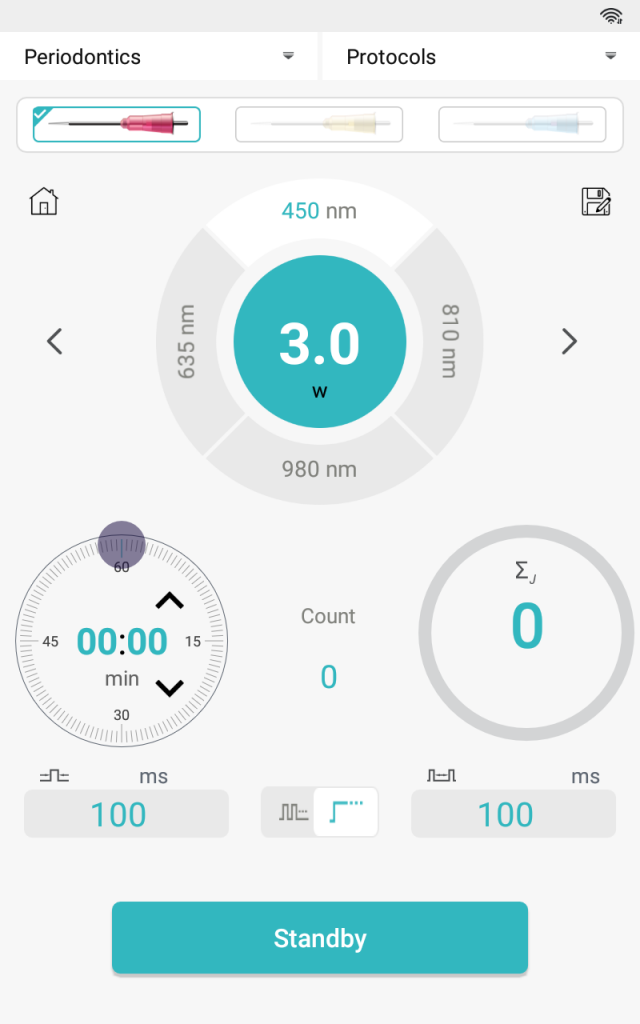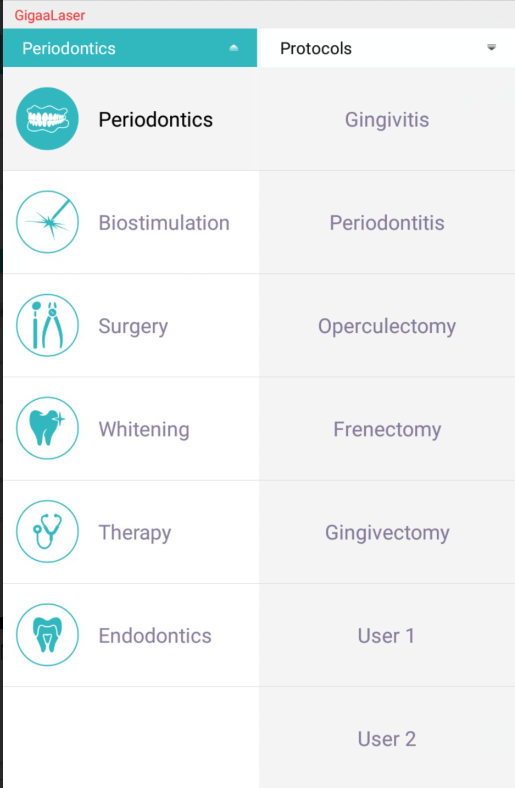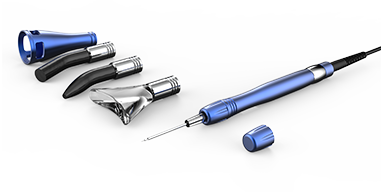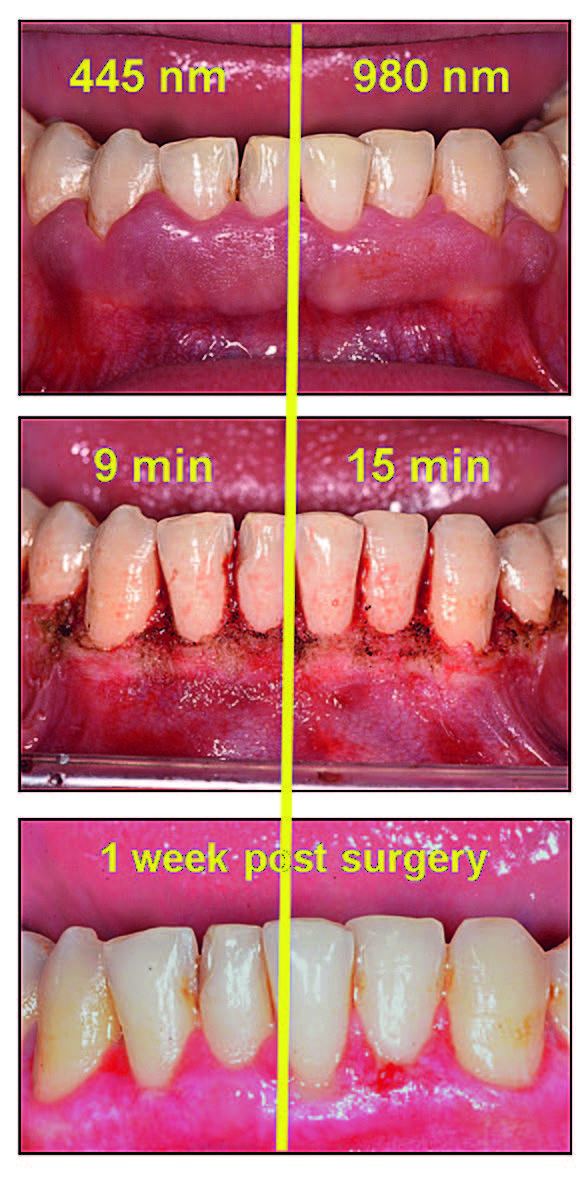FireLas four wavelength blue dental laser

FireLas Blue dental diode laser
Advanced Android OS smart dental diode laser
450nm blue laser advantages in dentistry
Blue dental laser represents an innovative extension to the already established surgery laser systems. “CO2 + KTP”-like laser unit for coagulation, vaporization and bloodless surgery thanks to its peak absorption in hemoglobin and its permeability in water. The blue laser light interacts better with the tissue components hemoglobin or melanin. At 450 nm, this enables considerably better and gentler cutting, even at lower power. Improved cutting performance make it ideally suited to all surgical applications and for hemostasis.
200mW 635nm Low Level Laser Therapy (LLLT) application in dentistry
Low-level laser applications in dentistry include the promotion of wound healing in a range of tissues and lesions.LLLT is useful for adjunctive treatment modality in various field of dentistry. It has a beneficial effect on both hard tissue and soft tissue of the oral cavity with less adverse effect.
Why choose Firelas blue dental laser


- 450nm, 635nm, 810nm, 980nm four wavelength in one machine, combine blue light and near-infrared, High power and low level together.
- Android OS software system offer extremely easy and friendly operation. Update software through WIFI.
- Pre-set protocols database for dentist.
- Pay one machine, own four wavelength together.
Jaw and TMJ Pain/Dysfunction
The Temporomandibular Joint (TMJ) is the joint of the jaw and connects the lower jawbone or mandible to the upper temporal bone which is part of the cranium (skull). Though pain or dysfunction of the temporomandibular joint is typically referred to as “TMJ”, it is just the name of the joint. The actual term for these symptoms is Temporomandibular Joint Disorder (or dysfunction). TMD is the abbreviated form of Temporomandibular Joint Disorder.
TMJ Disorder typically cause several problems such as jaw pain, jaw lock, jaw popping, and jaw clicking.
Why should you use laser therapy?
Of course there are several treatment methods available. Some such typical treatments are pain killers, dental splints, injections, massages, physical therapy, chiropractic or anti-inflammatory medications. But unfortunately these therapies work for some but don’t always resolve all the various form of TMJ pain for everyone, even after months and years of various treatment forms. This is because these therapies are not very successful to restore the displaced disk. The typical methods try to send blood to the affected areas and rely on available paths to send blood. If adequate amount of blood can be sent, the muscles and other affected parts will get energy and be healed. But TMD complications often block blood sending to the affected areas. So, typical therapies are often not very effective.
Laser technology has been so advanced that it is possible to restore the disk using this technology. Laser therapy can help TMD patients not only by restoring the displaced disc but also healing the nerves surrounding the disk. Laser therapy can send blood to the affected areas so that the muscles and other parts get enough energy to heal themselves.
Though high power lasers often have high penetration and dosage capabilities, it does not mean it will hurt or burn. The therapist does not need to cut any part of your body. This is safe when a trained therapist delivers deep tissue laser therapy.
Soft tissue procedures
- Gingival Troughing for Crown Impressions
- Gingivectomy & Gingivoplasty
- Gingival Incision & Excision
- Soft-Tissue Crown Lengthening
- Hemostasis & Coagulation
- Excisional & Incisional Biopsies
- Exposure of Unerupted Teeth
- Fibromal Removal
- Frenectomy & Frenotomy
- Implant Recovery
- Incision & Drainage of Abscess
- Leukoplakia
- Pulpotomy as an Adjunct to Root Canal Therapy
- Operculectomy
- Oral Papillectomies
- Reduction of Gingival Hypertrophy
- Vestibuloplasty
- Treatment of Canker Sores, Herpetic & Aphthous Ulcers of the Oral Mucosa

Peridontal procedures
- Sulcular Debridement (Removal of Diseased, Infected, Inflamed, & Necrosed Soft-Tissue in the Periodontal Pocket to Improve Clinical Indices Including Gingival Index, Gingival Bleeding Index, Probe Depth, Attachment Loss, & Tooth Mobility)
- Laser Soft-Tissue Curettage
- Laser Removal of Diseased, Infected, Inflamed & Necrosed Soft-Tissue Within the Periodontal Pocket
- Removal of Highly Inflamed Edematous Tissue Affected by Bacteria Penetration of the Pocket Lining & Junctional Epithelium
Laser teeth whitening
- Laser Assisted Whitening/Bleaching of Teethure.
Main Advantages
- Four wavelength 635nm, 445nm, 810nm and 970nm in one laser with Maxmium power up to 10Watt.
- Android OS smart laser
- HD Color Touch Screen
- Expert Preset Protocols
- Wifi update software
- Quite working fans
Technical Specifications
| Laser Type | GaAlAs Diode Laser |
| Model | FireLas |
| Wavelength | 635nm, 445nm ,810nm and 970nm |
| Maximum Power | 200mW+3W+7W+10W |
| Operation Mode | CW, Repeat Pulse |
| Pulse Duration | 10μs-3s |
| Repetition Rate | 0.2Hz-20KHz |
| Pilot Beam | Red Diode Laser Of 650nm, Power<5mW |
| Control Mode | Android OS |
| Voltage/Current Rating | 110/220 VAC, 5A , 50/60 Hz |
| Dimensions | 240(H)*130(W)*225(L) mm |
| Weight | 4kg |
| Safety Compliance | FDA |
| Specifications subject to change without notice. |
Contact now get better prices
International Distributors
UK Distributor
Company Name: CliniTech Medical LTD
Add: Kemp House, 152 -160 City Road, London, EC1V 2NX
Email: sales@clinitechmedical.co.uk
Website: www.clinitechmedical.co.uk
Tel: 01438 230037
